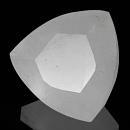|
|
|
|
Click on a letter above to view the list of gems. |
|
|
|
|
|
Hydrozincite |
|
| Chemistry: Zn5(CO3)2(OH)6 [Zinc Carbonate Hydroxide] | |
| Discovered
in 1853;
IMA
status: Valid (pre-IMA; Grandfathered). | ||
|
| ||
|
Classification |
|
|
| |
|
Carbonates | |
|
5/C.01-100 | |
|
|
5 : CARBONATES (NITRATES) |
|
Related to: |
Azurite - Rosasite Group and related compounds |
|
|
|
|
Crystal Data |
|
|
|
|
|
Crystals usually very small to microscopic, lath-like or bladed, flattened on {100} and elongated [001], often tapering to a sharp point. Typically found as massive aggregates of either powdery material, earthy and porous, to compact material, with fibrous radial structure, may be reniform. Dense agate-like masses, stalactic, and pisolitic. |
|
|
Contact twins on [100] |
|
|
|
|
|
Physical Properties |
|
|
|
|
|
[100] Perfect |
|
|
Irregular/Uneven |
|
|
Very Brittle |
|
|
2.0 - 2.5 |
|
|
3.50 - 4.00 (g/cm3) |
|
|
Fluoresces pale blue to lilac under SW UV |
|
|
Not Radioactive |
|
|
Other: |
Readily soluble in acids |
|
|
|
|
Optical Properties |
|
|
|
|
|
Colorless, White, Gray, pale shades of Yellow, Brown, Pink, Green, spherules may be concentrically color banded |
|
|
Transparent to Translucent, Opaque |
|
|
Pearly, Silky to Dull or Earthy in aggregates |
|
|
1.630 - 1.750 Biaxial ( - ) |
|
|
0.1200 |
|
|
Strong; r < v |
|
|
None |
|
|
|
|
|
Occurances |
|
|
|
|
|
Geological Setting: |
Uncommonly formed in the oxidized portions of zinc-bearing deposits, at the expense of sphalerite or smithsonite, and as incrustations in mine workings and caves. |
|
Common Associations: |
Aurichalcite, Calcite, Cerussite, Hemimorphite, Limonite, Smithsonite, Willemite |
|
Common Impurities: |
Fe, Cu |
|
Type Locality: |
Bad Bleiberg, Bleiberg District, Gailtaler Alpen & Karnische Alpen Mts, Carinthia, Austria |
|
Year Discovered: |
1853 |
|
View mineral photos: | |
|
|
|
|
More Information |
|
|
|
|
|
| |
|
|
|
|
Hydrozincite
is common worldwide but facetable crystals are very
rare. One source of these crystals is Zhejiang Province, China. |
|
|
We
have not photographed our Hydrozincite
gems. Please
check back soon. |
